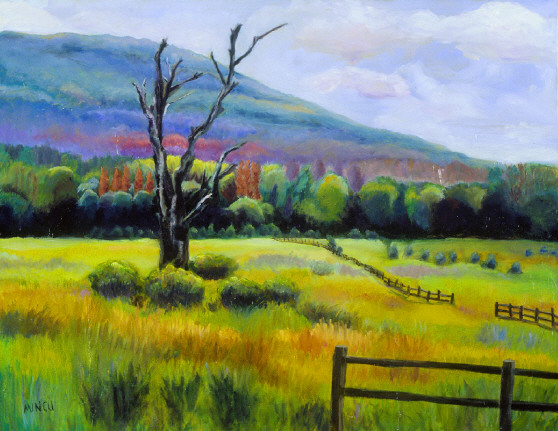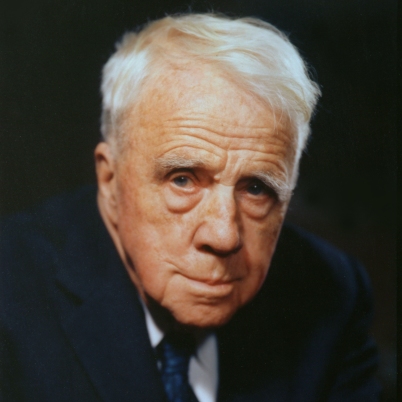‘Men build too many walls and not enough bridges’ -Isaac Newton. The poem “Mending Wall” by Robert Frost presents his ideas of barriers between people, communication, friendship and the sense of safety that people acquire from building barriers.
Summary of Mending Wall by Robert Frost
Lines 1-9: The narrator expresses his wonder about a phenomenon, through these lines, that he has observed in nature. He says that he has observed something mysterious takes place in nature which does not love the existence of walls. That ‘something’ makes the frozen ground to bloat under the wall and topple the stone wall on the boundary of his property. Hence, a gap is created in the wall through which two people can pass together. Robert Frost says that sometimes even careless hunters damage the walls but he drives them away and repairs the gap. The hunters pull down the stones of the walls. This way they search for rabbits hiding under the wall to please their barking dogs.
Lines 9-22: The poet rehearses the mystery of the wall. He says that no one has seen or heard the noise when the gaps in the walls are made. But these gaps are realities which are found during the spring when it is time for mending walls. The narrator makes his neighbour go beyond the hill to see the conditions there. One day, the narrator along with his neighbour decides to walk along the wall which separates their properties. They find stones fallen on the ground while they are walking. They pick up those stones from their respective sides. Some stones are shaped in bread loaves or some are shaped in round balls. Hence, the narrator and his neighbour are unable to put those stones back in their position. The narrator feels they need to use some kind of magic to put the stones back on the wall. During the process of handling the stones, their fingers are chapped and they feel tired. But the narrator and the neighbour look at it as an outdoor game, a kind of net game, where the wall acts like a net and the narrator and his neighbour are opponents.
Lines 22-36: The narrator tries to convince his neighbour that the wall is of no need because the narrator has an apple orchard while the neighbour own pine trees. He says that the apples that grow in his orchard would not trespass and eat the cones of his pine trees. To this, the neighbour replies, ‘Good fences make good neighbours.’ The narrator is not sure whether he can put an idea into the neighbour’s mind- the idea why good fences are required to keep cows at bay. If there are no cows, fences are not needed either. The narrator tells that if he has to ever build a wall, he will ask himself whom he will be protecting by constructing a wall and whether the wall will offend anyone. He believes that there is something that does not love walls and wants it to be pulled down.
Lines 37-46:
The narrator tells his friend that he believes some non-human entity like elves break the walls. The elves are tiny, supernatural beings from folklore and myth. But then the narrator changes his opinion and feels that it may not be the work of the elves but the power in nature which works against building of walls and barriers. The narrator sees his neighbour holding firmly a stone looking like an ancient stone-age man, armed to fight. The narrator feels that his neighbour is living in the darkness of ignorance. His neigbour does not want to go against his father’s words that good fences make good neighbours. Thinking for a while, his neighbour reiterates that ‘Good fences make good neighbours.’
Analysis of Mending Wall by Robert Frost
The theme of the poem is about two neighbours who disagree over the need of a wall to separate their properties. Not only does the wall act as a divider in separating the properties, but also acts as a barrier to friendship, communication. From the narrator’s view, barriers lead to alienation and emotional isolation and loneliness. The narrator cannot help but notice that the natural world seems to dislike the existence of a wall as much as he does and therefore, mysterious gaps appear from nowhere and boulders fall for no reason. The poem portrays the lack of friendship between two neighbours, they now each other but they are not friends. There exists a communication gap between them; they meet each other only on appointed days to fix the wall separating their properties.
Thus, the poem is a sad reflection on today’s society, where man-made barriers exist between men, groups, nations based on discrimination of race, caste, creed, gender and religion.
Form and Structure in Mending Wall:
“Mending Wall” is a poem of 46 lines without a neat stanza structure. It is a dramatic narrative poem composed in blank verse and also comprises of balanced strict Iambic pentameter lines.
The language of the poem is conversational in tone.
Poetical Devices:
Robert Frost has used a number of poetical devices to enhance the perception and feelings that he wants to communicate to the readers through an inanimate object, a wall.
Metaphor: Examples of metaphors in the poem are listed below;
1. The ‘wall’ in the poem is a metaphor for two kinds of barriers- physical and mental.
*Something there is that doesn’t love a wall
*And set the wall between us once again
*We keep the wall between as we go.
2. In another metaphor, stone blocks have been compared to ‘loaves’ and ‘balls.’
*And some are loaves and some so nearly balls
We have to use a spell to make them balance.
Simile used in Mending Wall:
Example of simile from the poem,-
“…I see him there
Bringing a stone grasped firmly by the top
In each hand, like an old-stone savage armed..”
In the above lines, Frost describes his neighbour who was holding a stone firmly in his hand and looked like some primitive man armed to fight.
Personification in Mending Wall:
“Something there is that doesn’t love a wall,
That sends the frozen-ground-swell under it,
And spills the upper boulders in the sun;”
In the above lines, an unseen force in nature has been personified. It is this force that breaks down the boundaries that man has created.
Parallelism:
It is a figure of speech that has a similar word order and structure in their syntax.
“To each the boulders that have fallen to each.”
Here, ‘to each’ is parallelism as it emphasizes that fact that the narrator and his neighbour are on the opposite sides of the wall.
Pun:
An example of Pun in the poem is “And to whom I was like to offence.” Here, the word ‘offence’ is a pun as it sounds like ‘fence.’
Paradox:
Frost’s poems are famous for juxtaposing the opposites for life. The poem has two famous lines which oppose each other.
“Something there is that doesn’t love a wall”
“Good fences make good neighbours.”
Allusion:
“Mending Wall” has an allusion to elves, the tiny supernatural creatures drawn from folklore and myth.
Alliteration:
The examples of alliteration in the poem are the following:
*We wear our fingers with handling them
*Before I built a wall
*What I was walling in or walling out.
Symbolism in Mending Wall:
Frost’s poems are known for his distinctive use of symbols. These symbols enhance the significance and deeper meaning of the poem.
*The fence symbolizes national, racial, religious, political and economic conflicts and discrimination which separate man from man and hinders the ways of understanding and cultivating relationships.
*The dispute between the two neighbours symbolizes the clash between tradition and modernity. The young generation wants to demolish the old tradition and replace it with modernity while the old wants to cling on to the existing tradition and beliefs.
In “Mending Wall”, Frost has taken an ordinary incident of constructing or mending a wall between the his and his neighbour’s garden and has turned it into a meditation on the division between human beings.
Dear Readers- If this summary/analysis has helped you, kindly take a little effort to like or +1 this post or both. Make sure you like Beamingnotes Facebook page and subscribe to our newsletter so that we can keep in touch. We’ll keep informing you about stuffs that are really interesting, worth knowing and adds importance to you.
Go through the Solved Questions
What does the wall represent in the poem, Mending Wall?
Keywords – mending wall summary (6.0), mending wall analysis line by line (5.0), mending wall summary line by line (3.6), summary of mending wall (5.9), mending wall symbolism (5.7)
Some online learning platforms provide certifications, while others are designed to simply grow your skills in your personal and professional life. Including Masterclass and Coursera, here are our recommendations for the best online learning platforms you can sign up for today.
The 7 Best Online Learning Platforms of 2022
- Best Overall: Coursera
- Best for Niche Topics: Udemy
- Best for Creative Fields: Skillshare
- Best for Celebrity Lessons: MasterClass
- Best for STEM: EdX
- Best for Career Building: Udacity
- Best for Data Learning: Pluralsight

















Excellent,precise, to the point!
tremedus language noce explaination
Really useful and precise…thanks..
Thanks for analysis mending walls
one does not uses the word, “narrator” in poems. It is in a story that one narrates and in a poem, one speaks. hence a speaker.
A poem can be in the form of a monologue or a narrative amongst countless others and hence, using the word narrator isn’t wrong.
Tell me the difference between a narrator and speaker, genius.
*use.
Wow I now clearly frostan the tension between the two
Was excellent…really helped me in my studies…?
Nice Notes.Helped a lot
Thank you .. it helped me understand the poem better
I got a lot of help from this site……. 🙂
Nice one. Read my poems sometimes hhh
Really good explanation better tha other sites.
I always depend on beamingnotes for my examinations. Great job!
Thank u ..Helped me a lot
It helps me in understanding this poem better…good job
thankyou so much. it is excellent. tomorrow is my exam of this poem and these notes helped me a lot
Its very helpful precise , to the point . thanks
It was really useful.thanks
It was excellent…….&It helped me 2 understand The poem…Thanku So much..☆☆
Nice explanation. Would be helpful for my exams
Such detailed explanations!❤️
It’s very helpful for me
Awesome and very helpful and descriptive stuff . keep helping other like this and thank you for this one . your work is really good and appreciative . keep it up !!!
Thank you
Perfect note but please make it more attractive and reader friendly. The summary is good and descriptive
Thank you for your help in learning the poem
Lots of love awfull….
Lol
Excellent …….. thank you for such a acctractive summary….